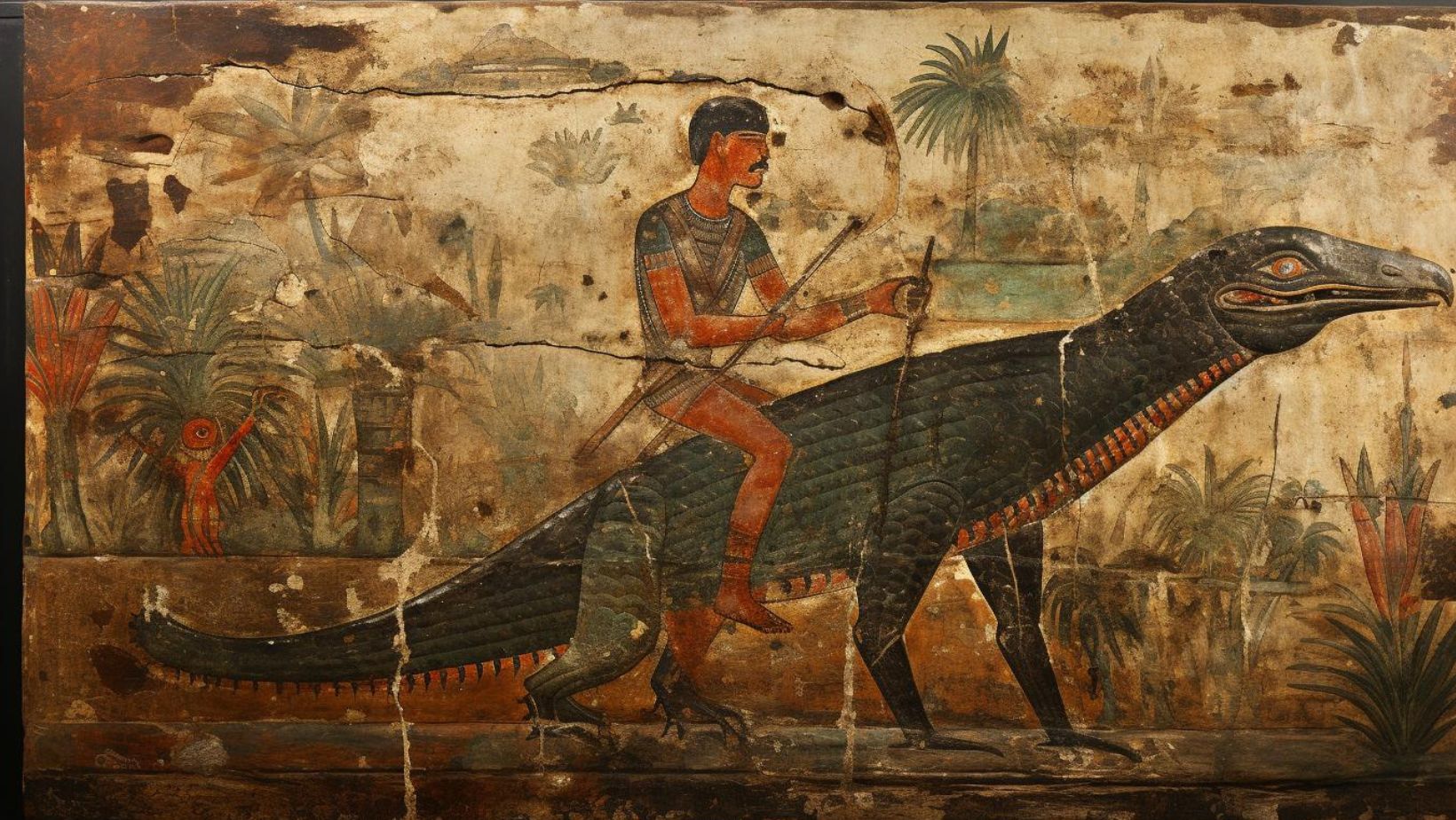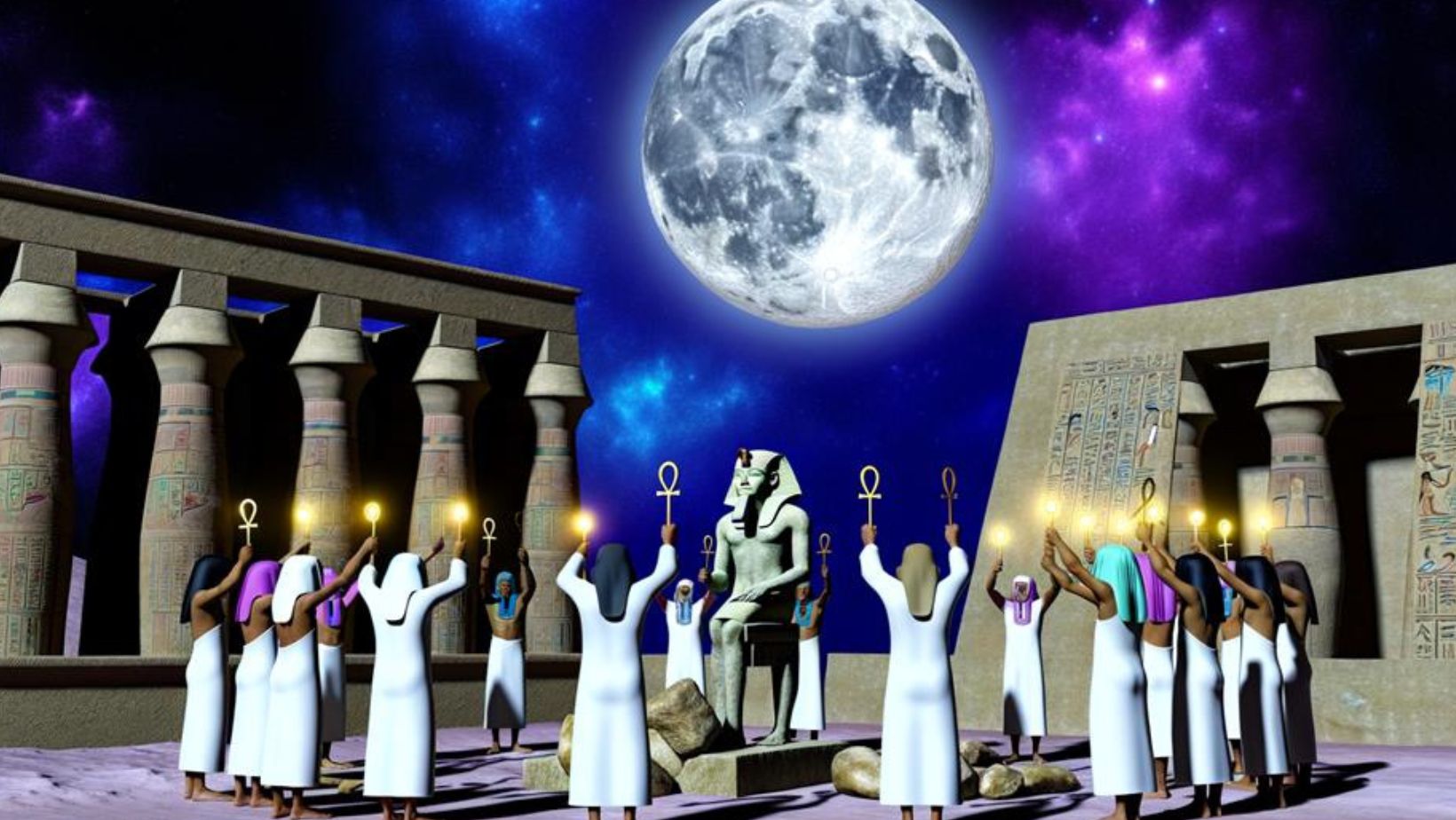Meet Khonsu, the enigmatic moon god of ancient Egypt. He’s more than just a celestial figure; He played a vital role in the lives of Egyptians, influencing their calendars, agriculture, and rituals. As the keeper of time and protector of travelers, He was revered for his healing powers.
Lunar deities, like Khonsu, held special significance in Egyptian religion. The moon’s cycles symbolized change and renewal, connecting the divine to the earthly. Join us as we explore the mysteries of Khonsu and uncover his fascinating place in the pantheon of ancient Egyptian gods.
The Mythological Origins of Khonsu

His origins are steeped in the rich tapestry of Egyptian mythology. He is often depicted as the son of Amun, the king of the gods, and Mut, the powerful mother goddess. This divine lineage grants him a unique status among the Egyptian deities. He embodies the lunar aspects that balance the solar attributes of his father, Amun.
In many myths, He is associated with the cycles of the moon. His name translates to “traveler,” reflecting his nocturnal journey across the night sky. This connection to lunar cycles made him crucial for timekeeping in ancient Egypt. His role extended beyond being a moon deity; he was also a protector and healer.
His relationship with Amun and Mut is significant. Together, they formed a powerful triad, symbolizing creation and renewal. This family dynamic highlights the interconnectedness of deities in Egyptian religion. By understanding his origins, we gain insight into the complex beliefs that shaped ancient Egyptian society.
Symbolism and Attributes of Khonsu
He is rich in symbolism that reflects his roles as a lunar deity. One of his most significant symbols is the crescent moon. This symbol represents his power over time and the passage of night. The crescent moon also signifies renewal and the cyclical nature of life.
Another important symbol associated with him is the hawk. This bird represents protection and vigilance, traits that Khonsu embodies. Often depicted with a hawk’s head, He illustrates his connection to the sky and his role as a guardian.
He attributes extend beyond mere symbolism. As a timekeeper, he regulated the lunar calendar, which was essential for agricultural planning. His association with healing is equally significant; he was believed to possess the power to cure ailments and protect individuals from harm.
In ancient Egypt, these attributes made him a vital deity for both personal and communal well-being. Worshippers looked to him for guidance during challenging times. His multifaceted symbolism continues to resonate in the study of ancient Egyptian mythology.
Khonsu in Egyptian Texts and Art
He appears prominently in ancient Egyptian texts, notably the Pyramid Texts and Coffin Texts. These texts often include spells and prayers that invoke his power for protection and healing. In the Pyramid Texts, he is called upon to aid the deceased on their journey through the afterlife. His presence underscores his importance in ensuring safe passage and renewal.
Artistic depictions of him can be found in various temples and tombs throughout Egypt. He is commonly shown as a young man with a sidelock of youth and a crescent moon atop his head. Sometimes, he is portrayed with a hawk’s head, symbolizing his connection to the sky and protection. These images reinforce his role as a guardian deity.
Temples dedicated to him, such as the Temple of Karnak, showcase elaborate carvings and reliefs depicting his myths and attributes. These artworks often celebrate his lunar powers and divine lineage. The consistent representation of him in texts and art highlights his significance in Egyptian religious practices and beliefs. Through these mediums, his legacy continues to be appreciated today.
Khonsu’s Role in the Egyptian Pantheon

He occupies a significant place in the Egyptian pantheon as the moon god. He is part of a complex network of deities, where each has distinct roles and attributes. As a child of Amun and Mut, he is associated with creation and renewal. His lunar aspect complements the solar attributes of Amun, highlighting the balance between day and night.
He interacts with several major gods and goddesses. Notably, he has a close relationship with Osiris, the god of the afterlife. In some myths, He aids Osiris by providing protection and guidance to souls journeying to the afterlife. Additionally, he is connected to Isis, Osiris’s wife, often collaborating with her in protective roles.
This dynamic among the gods showcases his importance in maintaining cosmic order. His role as a healer and protector aligns him with other deities concerned with life and death. His relationships within the pantheon reflect the interconnectedness of Egyptian mythology. Understanding these connections enriches our knowledge of ancient Egyptian beliefs and practices.
Festivals and Worship of Khonsu
The worship of Khonsu, the Egyptian god of the moon and time, was marked by grand festivals, with the Khonsu Festival as a highlight. This festival celebrated his power to drive away evil spirits and protect people from harm. Held annually, the Festival included processions where a statue of him was paraded through Thebes, allowing the public to seek his blessings. People would offer food, incense, and other offerings to gain his favor.
During these festivals, rituals focused on his role as a healer and protector. His worshippers would recite prayers and perform purification ceremonies to invite his divine protection. Temples dedicated to him, especially in Karnak, became centers for these practices, drawing followers who sought his guidance. The worship of Khonsu emphasized harmony, spiritual cleansing, and the hope of favorable blessings from the moon god.
In addition to the Festival, his worship was closely tied to lunar cycles. Priests would observe the moon phases and perform rituals that aligned with its changing phases, reflecting Khonsu’s influence on time and renewal. This connection made him central to Egypt’s religious life, embodying both physical protection and cosmic order.
Khonsu’s Influence on Timekeeping
Khonsu, the Egyptian god of the moon, played a crucial role in ancient Egyptian timekeeping. The lunar cycles governed by him were vital for tracking months, helping shape the Egyptian lunar calendar. Each month began with the new moon, marking time in a way directly tied to his influence. Egyptians relied on this lunar calendar for religious events and seasonal changes.
His association with the moon positioned him as a regulator of time, especially for night hours. As the moon god, he controlled phases that signified both the passage of days and the rhythm of celestial time. His worship involved observing the moon’s cycle, with priests interpreting its phases to predict and mark important dates. This practice reinforced his role as a divine timekeeper.
His influence extended into Egypt’s agricultural calendar, helping farmers determine planting and harvesting seasons. His lunar-based calendar influenced not only daily life but also significant festivals and rituals. This way, Khonsu’s presence connected Egyptians to cosmic order, reinforcing the importance of time in religious and social structures. Through Khonsu, time became both a spiritual guide and a practical framework for organizing life.
Legends and Myths Involving Khonsu

Khonsu, the Egyptian moon god, features in several myths and legends that highlight his powers and divine responsibilities. One notable story is his battle with Apep, the serpent of chaos who threatened the sun god Ra. He joined Ra in nightly battles against Apep, using his powers to protect the universe from disorder. This role as a warrior god reinforced his reputation as a protector of cosmic balance.
Another legend involving him encounter with the goddess Hathor. In this story, Hathor was sent to punish humanity but transformed into a fierce lioness, uncontrollable and destructive. He offered to calm her by sharing his own energy, helping her regain her gentle nature. This tale highlights his healing and balancing role, as he could soothe even the fiercest of gods.
He was also known as the “Traveler,” believed to roam the skies at night. This journeying aspect symbolized his influence over time and movement, connecting him with lunar cycles and transitions. These legends not only depict his strength and wisdom but also show his importance in maintaining harmony within the Egyptian pantheon. Through these stories, his character as a powerful yet compassionate god was solidified.
Khonsu’s Legacy in Later Cultures

Khonsu’s legacy extended beyond ancient Egypt, influencing later cultures and shaping beliefs about lunar deities. His association with the moon and time left a mark on Greco-Roman mythology, where similar moon gods emerged. In Greece, Selene and Artemis shared traits with him, including their connection to the night sky and protection. The Romans later adopted these deities, emphasizing the moon’s power over time and renewal, much like his role.
His protective aspects, especially in warding off evil, found parallels in later deities associated with healing and protection. His nightly journeys influenced myths of lunar deities traveling the sky, representing the passage of time and the rhythm of life. Through this, His concept of moon phases impacting time became embedded in Greco-Roman calendars and rituals. This connection solidified his influence on how other cultures viewed lunar cycles.
His image as a healer also found echoes in later beliefs. Lunar gods and goddesses were often linked to health, as the moon’s cycles were thought to influence wellness. His traits—timekeeping, healing, and protection—thus shaped lunar symbolism in different mythologies. His legacy continued, reflecting a powerful influence on the spiritual landscape of many ancient societies.
Conclusion: Khonsu: Decoding the Mysteries of Egypt’s Enigmatic Moon God
Khonsu’s mystique endures as a fascinating figure in Egyptian mythology, symbolizing time, healing, and protection. Modern interpretations highlight his role as a lunar deity deeply connected to cosmic order, making him an intriguing subject in studies of ancient spirituality. Today, His image resonates with the enduring appeal of lunar deities, reflecting humanity’s fascination with the moon’s influence on time and life. His legacy in mythology offers insights into ancient Egyptian beliefs while inspiring contemporary interest in the mysteries of the cosmos and the symbolic power of the moon across cultures.
FAQs About Khonsu: Decoding the Mysteries of Egypt’s Enigmatic Moon God
What symbols are associated with Khonsu in Egyptian mythology?
Khonsu is often symbolized by the lunar disk and the sidelock of youth. He appears as a young man with a sidelock and a headdress featuring a full moon atop a crescent, symbolizing his connection to the moon and time.
How did Khonsu’s role differ from other Egyptian lunar gods?
Unlike Thoth, who was also connected to the moon but focused on wisdom and writing, Khonsu’s role centered on healing, protection, and the regulation of time. Khonsu was unique in his direct connection to the moon’s phases, which influenced his power over time and order.
What were Khonsu’s relationships with other gods in the Egyptian pantheon?
Khonsu was considered the son of Amun and Mut in the Theban Triad. He often collaborated with other gods, such as Ra, by assisting in battles against chaotic forces, such as the serpent Apep.
Were there specific places dedicated to Khonsu’s worship?
Yes, Khonsu’s main temple was within the Karnak Temple Complex in Thebes, where his statue and rituals were a central part of religious life. This temple attracted worshippers who sought his blessings for health, protection, and guidance.
Why is Khonsu still significant in modern interpretations of mythology?
Khonsu represents the universal themes of timekeeping, healing, and lunar cycles, which continue to intrigue people today. His connection to the moon appeals to the timeless fascination with celestial bodies and their perceived influence on human life and nature.

